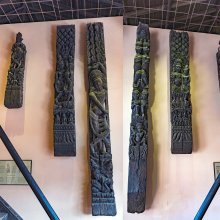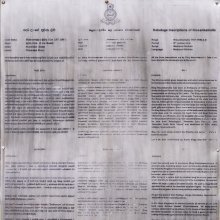Tuna, Tūṇa, Ṭunā, Tūṇā, Tunā: 18 definitions
Introduction:
Tuna means something in Hinduism, Sanskrit, Buddhism, Pali, Marathi, Jainism, Prakrit, biology. If you want to know the exact meaning, history, etymology or English translation of this term then check out the descriptions on this page. Add your comment or reference to a book if you want to contribute to this summary article.
Images (photo gallery)
In Hinduism
Sports, Arts and Entertainment (wordly enjoyments)
Source: archive.org: Syainika Sastra of Rudradeva with English Translation (art)Ṭunā (टुना) (or Ṭonā) refers to one of the eight kinds of Yellow-Eyed Hawks (known as the Pāṭalākṣā division), according to the Śyainika-śāstra: a Sanskrit treatise dealing with the divisions and benefits of Hunting and Hawking, written by Rājā Rudradeva (or Candradeva) in possibly the 13th century.—Accordingly, [while discussing the training of hawks]: “There are different ways of taming them according to the species to which they belong. There are two distinctly separate divisions, namely, ‘black-eyed’ and ‘yellow-eyed’ [e.g., Ṭunā]. The subdivisions of these are many. ”.

This section covers the skills and profiencies of the Kalas (“performing arts”) and Shastras (“sciences”) involving ancient Indian traditions of sports, games, arts, entertainment, love-making and other means of wordly enjoyments. Traditionally these topics were dealt with in Sanskrit treatises explaing the philosophy and the justification of enjoying the pleasures of the senses.
Biology (plants and animals)
Source: Google Books: CRC World Dictionary (Regional names)1) Tuna in Chile is the name of a plant defined with Opuntia ficus-indica in various botanical sources. This page contains potential references in Ayurveda, modern medicine, and other folk traditions or local practices It has the synonym Cactus decumanus Willd. (among others).
2) Tuna in India is also identified with Toona ciliata It has the synonym Cedrela mollis Handel-Mazzetti (etc.).
3) Tuna in Nigeria is also identified with Pseudocedrela kotschyi It has the synonym Soymida roupalifolia Schweinf. (etc.).
4) Tuna in Peru is also identified with Tropaeolum tuberosum It has the synonym Trophaeum tuberosus (Ruiz & Pav.) Kuntze (etc.).
Example references for further research on medicinal uses or toxicity (see latin names for full list):
· Flora Indica (1832)
· Supplementum Plantarum Succulentarum (1819)
· Hortus Dyckensis ou Catalogue des Plantes … Cactus (1834)
· Hort. Beng. (1814)
· Mem. Torrey Bot. Club
· Die Natürlichen Pflanzenfamilien (1897)
If you are looking for specific details regarding Tuna, for example health benefits, chemical composition, extract dosage, diet and recipes, pregnancy safety, side effects, have a look at these references.

This sections includes definitions from the five kingdoms of living things: Animals, Plants, Fungi, Protists and Monera. It will include both the official binomial nomenclature (scientific names usually in Latin) as well as regional spellings and variants.
Languages of India and abroad
Pali-English dictionary
Source: BuddhaSasana: Concise Pali-English Dictionarytūṇa : (m.) a quiver.

Pali is the language of the Tipiṭaka, which is the sacred canon of Theravāda Buddhism and contains much of the Buddha’s speech. Closeley related to Sanskrit, both languages are used interchangeably between religions.
Marathi-English dictionary
Source: DDSA: The Molesworth Marathi and English Dictionarytūṇa (तूण).—m S tūṇīra m S A quiver.
Source: DDSA: The Aryabhusan school dictionary, Marathi-Englishṭuṇa (टुण) [-kan-kara-dinī-diśī, -कन्-कर-दिनी-दिशी].—
--- OR ---
tūṇa (तूण).—m A quiver.
Marathi is an Indo-European language having over 70 million native speakers people in (predominantly) Maharashtra India. Marathi, like many other Indo-Aryan languages, evolved from early forms of Prakrit, which itself is a subset of Sanskrit, one of the most ancient languages of the world.
Sanskrit dictionary
Source: DDSA: The practical Sanskrit-English dictionaryTūṇa (तूण).—[tūṇ-karmaṇi ghañ] A quiver; मिलितशिलीमुखपाटलिपटलकृतस्मरतूणविलासे (militaśilīmukhapāṭalipaṭalakṛtasmaratūṇavilāse) Gītagovinda 1; R.7.57.
-ṇī 1 An internal disease by which the anus and the bladder become painfully affected.
2) The indigo plant.
3) A quiver; धनुर्गृहीत्वा तूणी च खङ्गं च रुचिरप्रभम् (dhanurgṛhītvā tūṇī ca khaṅgaṃ ca ruciraprabham) Rām.7.75.9; R.9.59; Uttararāmacarita 4.2; Mv.1.18.
Derivable forms: tūṇaḥ (तूणः).
--- OR ---
Tūṇā (तूणा).—f. A bellows; L. D. B.
Source: Cologne Digital Sanskrit Dictionaries: Edgerton Buddhist Hybrid Sanskrit DictionaryTuṇa (तुण).—(m. or nt.; compare tūṇa, tuṇava; AMg. tuṇā [tuṇa?], an unidentified mus. instrument), some musical instru- ment: in lists, tuṇa-paṇava-mṛdaṅgāṃ Lalitavistara 80.5; tuṇa- veṇu-(text vaiṇu-)-ravaiḥ 173.9; tuṇa-vīṇā-sughoṣakādi- bhiḥ 177.14. Tibetan confused; it may intend this word by rgyud gcig (pa) in the first two (see under tuṇava), but if so the order varies from our text; on 177.14 this Tibetan word does not occur, and tuṇa may be gliṅ bu (otherwise = veṇu or vaṃśa), altho the order suggests sgra sñan, but this elsewhere = sughoṣaka. In spite of Tibetan, which suggests a stringed (or in 177.14 a wind?) instrument, perhaps really a kind of drum.
--- OR ---
Tūṇa (तूण).—and tūṇaka (m. or nt.; compare tuṇa, and AMg. tūṇaya), a musical instrument, perhaps a kind of drum (= tuṇa?): tūṇa- (Senart em. tūṇava-)-paṇava-vīṇā- (so read; Senart veṇu-) Mahāvastu iii.113.5; kācit (of the harem- women) tūṇakaṃ Mahāvastu ii.159.5; in same scene iii.407.18 kāci tūṇaṃ; in these passages little evidence as to the nature of the instrument; compare kumbhatūṇa, apparently also a kind of drum.
Source: Cologne Digital Sanskrit Dictionaries: Shabda-Sagara Sanskrit-English DictionaryTūṇa (तूण).—mf. (-ṇaḥ-ṇā or -ṇī) A quiver, &c. f. (-ṇī) Indigo. E. tūṇ to be filled (with arrows, &c.) ac and ṭāp affixes, or karmaṇi ghañ and ṅīṣ . tūṇyate bāṇaiḥ .
Source: Cologne Digital Sanskrit Dictionaries: Benfey Sanskrit-English DictionaryTūṇa (तूण).—and tūṇi tūṇi, I. m. and f. ṇī, A quiver, [Harivaṃśa, (ed. Calc.)] 15940; [Rāmāyaṇa] 1, 48, 3; 2, 31, 30. Ii. f. ṇī, A disease of the nerves, [Suśruta] 1, 232, 8.
Source: Cologne Digital Sanskrit Dictionaries: Cappeller Sanskrit-English DictionaryTūṇa (तूण).—[masculine] ī [feminine] (adj. —° tūṇaka) quiver.
Source: Cologne Digital Sanskrit Dictionaries: Monier-Williams Sanskrit-English Dictionary1) Tuna (तुन):—[varia lectio] for tana, [Sāma-veda i, 5, 1, 1, 5.]
2) Tūṇa (तूण):—m. ([gana] śoṇādi; [gana] gaurādi [varia lectio]) ‘bearer’ (√tul), a quiver, [Mahābhārata] etc. (often [dual number])
Source: Cologne Digital Sanskrit Dictionaries: Yates Sanskrit-English DictionaryTūṇa (तूण):—[(ṇaḥ-ṇā-ṇī)] 1. m. f. A quiver. 3. f. (ṇī) Indigo.
Source: DDSA: Paia-sadda-mahannavo; a comprehensive Prakrit Hindi dictionary (S)Tūṇa (तूण) in the Sanskrit language is related to the Prakrit words: Tūṇa, Tūṇā, Tūṇi, Toṇa.
[Sanskrit to German]
Sanskrit, also spelled संस्कृतम् (saṃskṛtam), is an ancient language of India commonly seen as the grandmother of the Indo-European language family (even English!). Closely allied with Prakrit and Pali, Sanskrit is more exhaustive in both grammar and terms and has the most extensive collection of literature in the world, greatly surpassing its sister-languages Greek and Latin.
Prakrit-English dictionary
Source: DDSA: Paia-sadda-mahannavo; a comprehensive Prakrit Hindi dictionary1) Tūṇa (तूण) in the Prakrit language is related to the Sanskrit word: Tūṇa.
2) Tūṇā (तूणा) also relates to the Sanskrit word: Tūṇā.
2) Tūṇā has the following synonyms: Tūṇi.
Prakrit is an ancient language closely associated with both Pali and Sanskrit. Jain literature is often composed in this language or sub-dialects, such as the Agamas and their commentaries which are written in Ardhamagadhi and Maharashtri Prakrit. The earliest extant texts can be dated to as early as the 4th century BCE although core portions might be older.
Kannada-English dictionary
Source: Alar: Kannada-English corpusTūṇa (ತೂಣ):—
1) [noun] the state of the mind influenced by higher degree of joy, delight, happiness, etc., usu. beyond the control of one’s will.
2) [noun] the state of being possessed by supposed supernatural powers; a particular kind of crazy state of the mind.
3) [noun] a desire that cannot be suppressible.
4) [noun] intense enthusiasm; ardent endeavour; zeal.
--- OR ---
Tūṇa (ತೂಣ):—[noun] a strong piece of timber set upright in to the ground.
--- OR ---
Tūṇa (ತೂಣ):—[noun] = ತೂಣೀರ [tunira].
--- OR ---
Tūṇa (ತೂಣ):—[noun] Yama, the God of Death who awards punishment to dead commensurable with their sinful actions.
--- OR ---
Tūna (ತೂನ):—[noun] = ತೂಣ [tuna]2.
Kannada is a Dravidian language (as opposed to the Indo-European language family) mainly spoken in the southwestern region of India.
Nepali dictionary
Source: unoes: Nepali-English Dictionary1) Ṭunā (टुना):—n. witchcraft; incantation; charm;
2) Tunā (तुना):—n. pl. of तुनो [tuno]
3) Tūṇa (तूण):—n. quiver (of arrows);
Nepali is the primary language of the Nepalese people counting almost 20 million native speakers. The country of Nepal is situated in the Himalaya mountain range to the north of India.
See also (Relevant definitions)
Starts with (+19): Tuna anis, Tuna camuesa, Tuna cardona, Tuna de castilla, Tuna de espana, Tuna mansa, Tuna mashua, Tuna real, Tuna tapona, Tuna-Kana-Kara-Dini-Dishim, Tuna-nikanananiyayam, Tunadhara, Tunagenasu, Tunagollu, Tunai, Tunailla, Tunaka, Tunakamijaja, Tunakana, Tunaku.
Query error!
Full-text (+53): Tunatuna, Tunadhara, Tuni, Tunamaram, Purnatuna, Tunavat, Tunamukha, Tunatuni, Tunagenasu, Banatuna, Tunira, Tunin, Tun, Tuna-Kana-Kara-Dini-Dishim, Tunam, Tunamana, Tunamara, Velvittunam, Tunavant, Tunah.
Relevant text
Search found 25 books and stories containing Tuna, Tūṇa, Ṭuṇa, Ṭunā, Tūṇā, Tuṇa, Tūna, Tunā, Tuna-a, Tūṇa-a; (plurals include: Tunas, Tūṇas, Ṭuṇas, Ṭunās, Tūṇās, Tuṇas, Tūnas, Tunās, as). You can also click to the full overview containing English textual excerpts. Below are direct links for the most relevant articles:
Sahitya-kaumudi by Baladeva Vidyabhushana (by Gaurapada Dāsa)
Text 10.42 < [Chapter 10 - Ornaments of Meaning]
Text 4.33 < [Chapter 4 - First-rate Poetry]
Bhakti-rasamrta-sindhu (by Śrīla Rūpa Gosvāmī)
Verse 2.4.77 < [Part 4 - Transient Ecstatic Disturbances (vyābhicāri-bhāva)]
Amarakoshodghatana of Kshirasvamin (study) (by A. Yamuna Devi)
Grammatical explanation of Amarakośa’s preamble < [Chapter 6 - Grammatical Aspects]
Brihat Jataka by Varahamihira [Sanskrit/English] (by Michael D Neely)
Verse 27.30 < [Chapter 28 - Conclusion]
Verse 27.9 < [Chapter 28 - Conclusion]
Verse 27.21 < [Chapter 28 - Conclusion]
World Journal of Pharmaceutical Research
Environmental mercury toxicity in fish < [2017: Volume 6, January issue 1]
Seasonal variations of mercury in edible tissues of labio rohita and catla catla < [2018: Volume 7, January issue 1]
Omega-3 fatty acid used to treat dementia < [2023: Volume 12, December issue 21]
Harshacharita (socio-cultural Study) (by Mrs. Nandita Sarmah)
Part 9.4: Weapons of the War < [Chapter 5 - Political Aspects]


